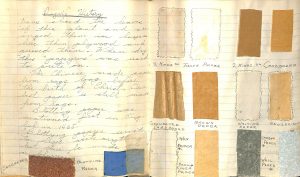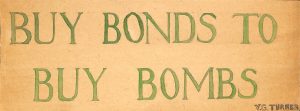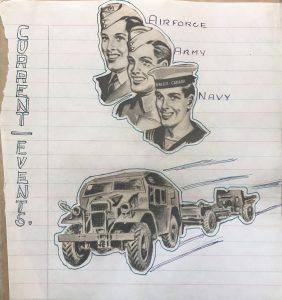It seems in every classroom that there’s always one exceptional note-taker – whose handwriting is neat, whose attendance is spotless, and commitment to capturing every detail of a lesson fills page after organized page. At the North Toronto Collegiate Institute (NTCI), this student was Vernon G. Turner, whose meticulous notes for every class that he took between 1943 and 1948 have recently been archived at OISE Library.
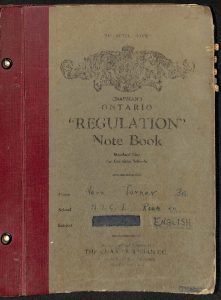
An English notebook from third form. Almost all of Turner’s notes were taken in these Chapman notebooks.
As one may surmise by the enthusiasm for which he took his school notes – particularly in subjects relating to history, languages and geography – Turner went on to have a successful career as a Canadian foreign ambassador, serving the USSR, Mongolian People’s Republic, Israel and Cyprus before his retirement in 1991. In 1996, Turner found his high school notebooks in an old trunk*, accompanied by a collection of drawings, art projects, and workbooks from his elementary school days at Maurice Cody Public School in North Toronto’s Leaside neighborhood. Already familiar with OISE Press after recording a tape interview on Canadian foreign policy in the 1970s, Turner donated the notebooks to the institution, along with artwork, yearbook photographs, and a record of the teacher and subjects he encountered at NTCI. Turner’s collection will be preserved in the OISE Library’s Ontario Historical Education Collections (OHEC), and detailed descriptions of these materials can now be found through Discover Archives, the University of Toronto’s shared archival portal.
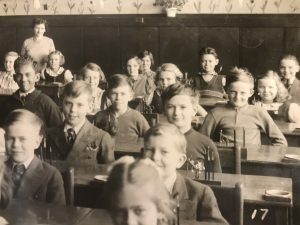
Vernon (third row from front, extreme right) and his Grade 1 classmates at Maurice Cody Public School.
While the OHEC collects documentation surrounding the development of public schools in Ontario including textbooks, Ministry of Education reports and provincial exams, few of its records come from students themselves. While the items in the OHEC can help researchers keep track of the educational resources mandated by the Ontario government, they do not encapsulate everything that has been taught in classrooms, as lesson plans, activities and supplementary materials are usually determined by the individual discretion of school boards and teachers. This is what makes the Vernon G. Turner fonds so valuable; not only does it contribute to our understanding of what it was like to attend high school in Toronto during the years surrounding the Second World War, but it shows the progression of a single student throughout his education, providing a comprehensive record of what he learned in school and the role that his education may have played in shaping his future.
Turner’s donation includes 26 notebooks that correspond to subjects taken during high school Forms 1-5. A typical school year involved year-long courses in English, French, Mathematics, Science, and History. Courses in Latin, German, and Library were added in second and third forms, while core subjects became more specific. Turner’s penultimate year of high school was his most academically diverse, with courses ranging in Meteorology, Health, Geometry, Modern History, as well as English, French, Latin, and German. Many of Turner’s notes would be relevant to modern students; his third year Mathematics notebooks is full of missing-angle equations, his fourth year notebook details Napoleon’s invasion, and his English notebooks contain several notes on Shakespeare.
Other notebooks provide reminders of childhood in the 1940s. Significant are the notes revealing Turner’s classroom perspective of World War II. A small notebook from 1941 titled “Current Events” lists the unfolding events of WWII in Turner’s early cursive, including the German siege of Kiev in September and the actions of US warships. One page is dedicated to memorizing the different hats of army, navy, and air force soldiers, the images of which Turner has carefully labelled. Many of Turner’s notebooks suggest an emphasis on classroom crafts. His science notebooks are more akin to scrapbooks, with dried foliage, seeds, and textile samples such as cotton and woodchips glued into the pages. The young Turner also made several stories and booklets, ranging in subject from pirate conquests to math vocabulary to a diagram of the human ear.
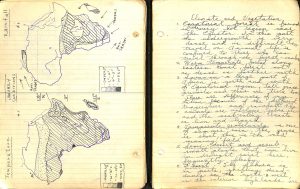
Turner had an affinity for history, geography, and languages. His notes were often accompanied by hand-drawn maps and diagrams.
The complete fonds also tracks the development of Turner’s interest in historical affairs. In elementary school, he produced several maps that were carefully colored and labelled. At the end of Form 1, his Social Studies notebook was by far the largest and most detailed of his first year notebooks, and preserved a twenty-page appendix of world maps. In Form 4, his Modern History notes span two full notebooks, and in Form 5, Turner focused exclusively History and Language courses, including Latin, German and French. Turner went on to earn a master’s degree in German History, at which time his professor suggested that he join the Canadian Foreign Service. As part of his diplomatic career, Turner also served on the United Nations, and attended the New York consulate in the late 1960s.
The contents of the Vernon G. Turner fonds can be viewed by making an appointment to visit the Ontario Historical Education collections. The collection’s Discover Archives page provides detailed descriptions to help you prepare for your visit – either view the Finding Aid, or select an item through the drop-down menu. Select items are also on display in OISE Library in the glass table by the ground floor elevators.
* Information taken from OISE Press newspaper article: (June/July 1994). New material for textbook collection. OISE Press.

